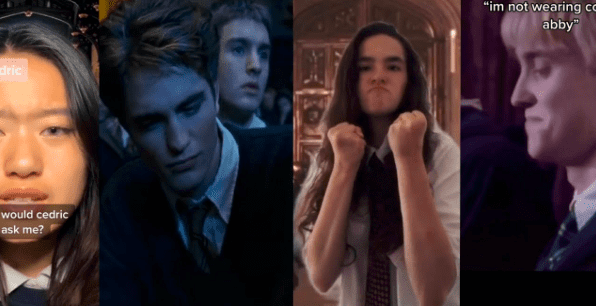I am no stranger to the realm of fanfiction. I have spent many late hours of the night curled up on my side on AO3 (archive of our own), stolen moments between tutorials reading about Harry Styles being Cheshire’s Pablo Escobar, long minutes scrolling through books of BadBoy!AUs on Wattpad. I am no stranger to being Y/N. What I am, however, a stranger to is being POV-choked through my phone by someone cosplaying as Draco Malfoy.
There is little debate surrounding what qualifies as ‘fanfiction.’ It can be argued that Dante’s Inferno and John Milton’s Paradise Lost is Bible fanfiction, or that Virgil’s Aeneid is Iliad fanfiction. The line between great works of literature and trashy NewStudent!AUs is not as blurry as scholars might want to admit. But the subculture has evolved since then: from Star Wars and Star Trek fanzines to boyband members as mafia bosses to minute-long videos on TikTok.
In the late twentieth century, fanfiction — primarily written by women who reimagined popular texts and situated their plots in feminist narratives — was limited to the physical page. But as it evolved, fanfiction became less of a political statement and more for the purposes of entertainment. The first half of the 2010s saw online platforms like Wattpad flooded with ‘books’ about real people — pages and pages on pop stars like Justin Bieber and One Direction placed in high schools and small towns and drug lord dens. In theory, popular Harry Styles fanfic turned bestselling book and then major motion picture After is comparable to The Three Musketeers by Alexandre Dumas.
Preteens and teenagers are the driving force behind Wattpad’s success; but Wattpad isn’t the only app they have popularised for fanfiction. TikTok, a Vine-esque video-sharing app, is a new host for the genre. But TikTok’s format means the content has a time cap of one minute — which has excluded many genres of fanfiction. Slow burn fics, for instance, can go as far as having seventy thousand words before the character pairing even interacts. But TikTok fanfiction allows for an audio-visual experience that hasn’t previously been tapped into. Watching people dress up in a green and silver scarf, or with piercing blue contact lenses and store-bought fangs, or open white shirts with butterflies on their chest is a new form of intimacy, to say the least. TikTok creates an inadvertent immersive experience of fanfiction. POV (point of view) videos are structured to insert the viewer directly into the context of the scene — they are there, with the character; they are being pushed up against a wall; they are being held hostage with a sword under their chin.
American scholar Henry Jenkins famously described stereotyped representations of fans in popular culture and academic criticism, likening them to shameless, undisciplined cultural scavengers. However, more recently, active and creative behaviour by audiences has been instrumental to the commercial successes of popular cultural artefacts (mainly film and novel franchises). There is a semiotic democracy in which active audiences reinterpret texts in creative and personal methods, effectively questioning established power hierarchies in the process. Writing and consuming fanfiction actively causes people to fragment and reassemble texts, joining broken shards together to fit the picture they have in their mind. By recreating the texts, they are able to form more inclusive material a larger audience can engage with. Fanfiction was — and still is — considered entertainment enjoyed by the ‘lowest’ members of society: teenage girls, women and queer people.
But despite popular derision, fanfiction is slowly beginning to be understood as an important popular cultural artefact. Most fanfiction, especially those found on sites like AO3, can be better thought-out and more holistic than the source text. Is TikTok fanfiction worthy of the same degree of consideration and discourse we have placed on their written counterparts? Honestly, probably not. But does it have to be for us to enjoy it and admit that it is culturally significant?
TikTok POV videos are in their infancy. The people who produce them do not do so with the intent to make subculture history — it started as a method to place beloved characters in different settings, pushing the limits of what is traditionally accepted in the genre. It is a means to share and explore experiences of sexuality, to form relationships with a like-minded community, to have an excuse to bleach your hair ash blond and carry around a stick from your backyard. The first time I saw someone cosplay as Draco, I absentmindedly scrolled past it, not realising that moment would later turn into a flashbulb memory. Henry Jenkins might not appreciate people in repurposed bathrobes with fake blood dripping down their chins, but what does that say about him?





